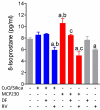Environmentally persistent free radicals amplify ultrafine particle mediated cellular oxidative stress and cytotoxicity
- PMID: 19374750
- PMCID: PMC2676242
- DOI: 10.1186/1743-8977-6-11
Environmentally persistent free radicals amplify ultrafine particle mediated cellular oxidative stress and cytotoxicity
Abstract
Background: Combustion generated particulate matter is deposited in the respiratory tract and pose a hazard to the lungs through their potential to cause oxidative stress and inflammation. We have previously shown that combustion of fuels and chlorinated hydrocarbons produce semiquinone-type radicals that are stabilized on particle surfaces (i.e. environmentally persistent free radicals; EPFRs). Because the composition and properties of actual combustion-generated particles are complex, heterogeneous in origin, and vary from day-to-day, we have chosen to use surrogate particle systems. In particular, we have chosen to use the radical of 2-monochlorophenol (MCP230) as the EPFR because we have previously shown that it forms a EPFR on Cu(II)O surfaces and catalyzes formation of PCDD/F. To understand the physicochemical properties responsible for the adverse pulmonary effects of combustion by-products, we have exposed human bronchial epithelial cells (BEAS-2B) to MCP230 or the CuO/silica substrate. Our general hypothesis was that the EPFR-containing particle would have greater toxicity than the substrate species.
Results: Exposure of BEAS-2B cells to our combustion generated particle systems significantly increased reactive oxygen species (ROS) generation and decreased cellular antioxidants resulting in cell death. Resveratrol treatment reversed the decline in cellular glutathione (GSH), glutathione peroxidase (GPx), and superoxide dismutase (SOD) levels for both types of combustion-generated particle systems.
Conclusion: The enhanced cytotoxicity upon exposure to MCP230 correlated with its ability to generate more cellular oxidative stress and concurrently reduce the antioxidant defenses of the epithelial cells (i.e. reduced GSH, SOD activity, and GPx). The EPFRs in MCP230 also seem to be of greater biological concern due to their ability to induce lipid peroxidation. These results are consistent with the oxidizing nature of the CuO/silica ultrafine particles and the reducing nature and prolonged environmental and biological lifetimes of the EPFRs in MCP230.
Figures









References
Grants and funding
LinkOut - more resources
Full Text Sources

